
St. Mary’s Roman Catholic Church
Iowa City, Iowa
Moline Organ Co., 1883
Restored by Dobson Pipe Organ Builders, 2015
|
GREAT
|
|
|
|
|
| 16' |
|
Double Open Diapason |
13-24 fr VdG
|
34 pipes |
| 16' |
|
Contra Diapason |
|
12 pipes |
| 8' |
|
Open Diapason |
|
58 pipes |
| 8' |
|
Viol di-Gamba [sic] |
|
58 pipes |
| 8' |
|
Hohl Flute |
|
58 pipes |
| 4' |
|
Principal |
|
58 pipes |
| 4' |
|
Flute Harmonic |
|
58 pipes |
| 2-2/3' |
|
Twelfth |
|
58 pipes |
| 2' |
|
Fifteenth |
|
58 pipes |
| IV |
|
Mixture |
|
232 pipes |
| 8' |
|
Trumpet |
|
58 pipes |
|
|
Swell to Great |
|
|
|
|
Choir to Great |
|
|
| |
|
 |
|
|
|
SWELL (enclosed)
|
|
|
| 16' |
|
Lieblich Gedact |
|
46 pipes |
| 8' |
|
Lieblich Bourdon |
|
12 pipes |
| 8' |
|
Open Diapason |
|
58 pipes |
| 8' |
|
Salicional |
|
58 pipes |
| 8' |
|
Quintadena |
|
58 pipes |
| 8' |
|
Stopped Diapason |
|
58 pipes |
| 4' |
|
Fugara |
|
58 pipes |
| 4' |
|
Flauto Traverso |
|
58 pipes |
| 2' |
|
Flautino |
|
58 pipes |
| 8' |
|
Oboe |
BB
|
47 pipes |
| 8' |
|
Bassoon |
|
11 pipes |
|
|
Tremolo |
|
|
|
|
 |
|
|
|
CHOIR
|
|
|
|
|
| 8' |
|
Keraulophone |
|
58 pipes |
| 8' |
|
Dulciana |
1-7 Melodia
|
51 pipes |
| 8' |
|
Melodia |
|
58 pipes |
| 4' |
|
Flute d’Amour |
|
58 pipes |
| 2' |
|
Flageolet |
|
58 pipes |
| 8' |
|
Clarionette |
TC
|
46 pipes |
|
|
Swell to Choir |
|
|
| |
|
|
|
|
|
PEDALE
|
|
|
|
|
| 16' |
|
Grand Open Diapason |
|
27 pipes |
| 16' |
|
Sub Bass |
|
27 pipes |
| 8' |
|
Bass Flute |
ext. Sub Bass
|
12 pipes |
|
|
Great to Pedale |
|
|
|
|
Swell to Pedale |
|
|
|
|
Choir to Pedale |
|
|
| |
|
|
|
|
|
|
Bellows Signal |
|
|
|
|
Pedale Check |
|
|
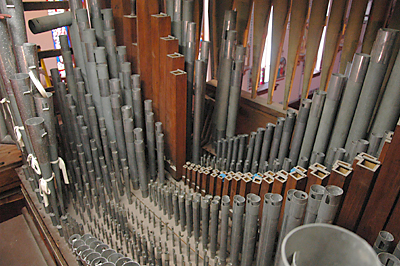
A general view of the Great.
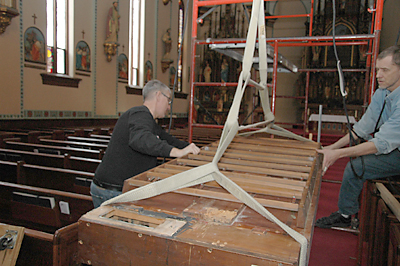
Removing one of the Pedale ventil chests.
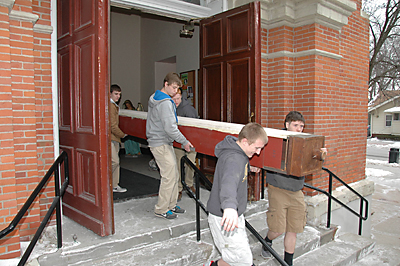
One of the largest pipes of the Pedale Grand Open Diapason heads back to Lake City for repair of splits.

Members of the Dobson crew with parish member Kirk Phillips.
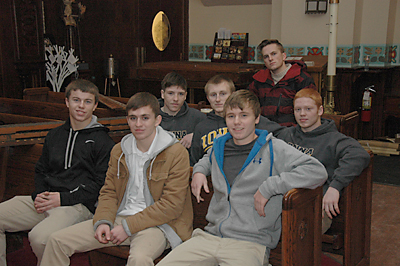
Parish students at Regina High School helped with the organ’s removal.
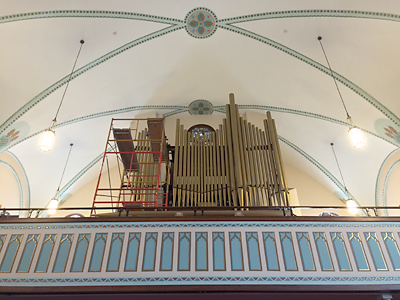
Many of the façade pipes’ tuning scrolls had been broken after 130 years of tuning. Part of the restoration work included the installation of new metal tuning scrolls.
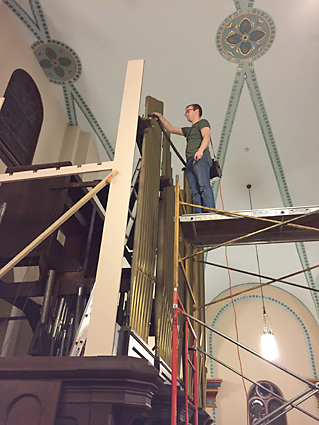
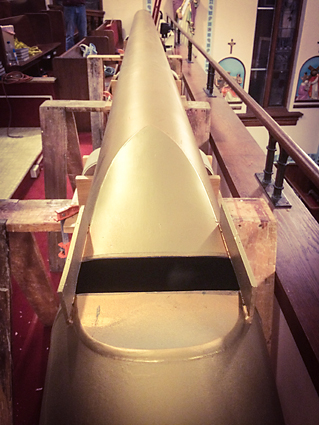
The rounded form of the upper lip and the substantial thickness of the ears betrays the British roots of Moline’s pipemakers.
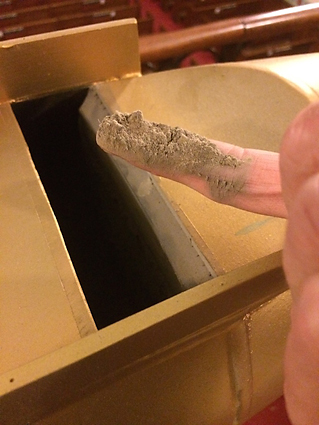
The dust of ages.
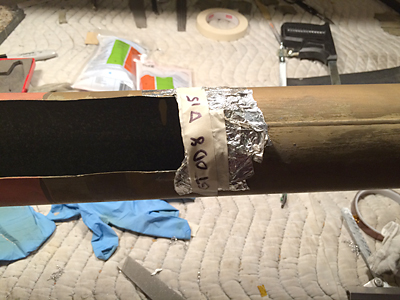
This is how many of the façade pipes were tuned.

Ben cuts a proper rectangular opening for the new scroll.
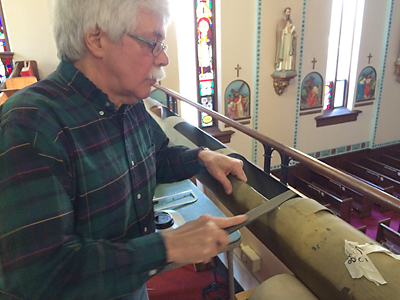
Bill files the edges of the rectangular opening to receive new solder.
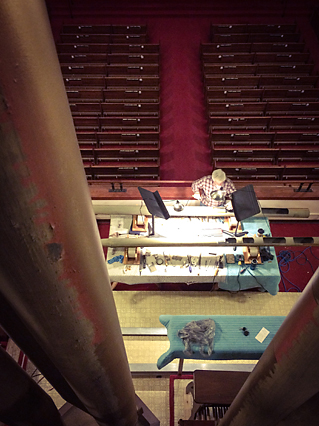
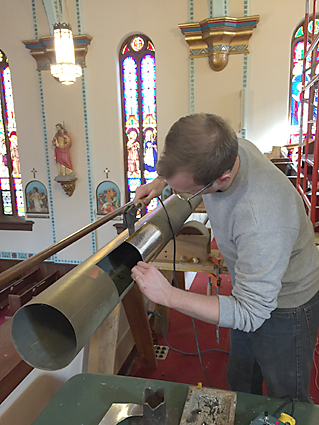
Ben solders a new insert of spotted metal.
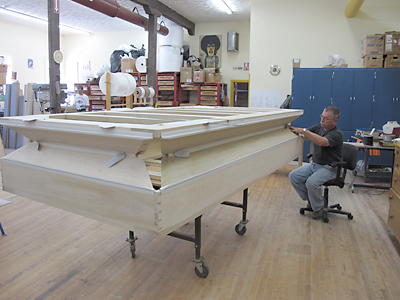
The original 1883 bellows were discarded by Kilgen in the 1940s. The organ has suffered under the inadquate replacement reservoir since then. Although there weren’t funds to build a double-rise bellows similar to what would have been originally supplied by Moline, we did construct a new single-rise bellows that, at 5' x 9' with large ribs, contains more than twice the volume of the old 4' x 6' reservoir.
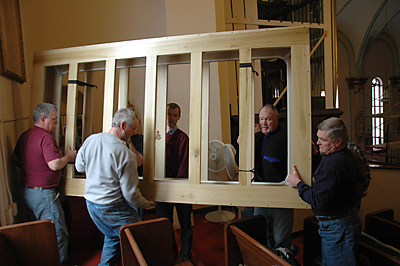
The new bellows is maneuvered into the balcony. The covers have been removed to reduce the weight and make it easier to handle.
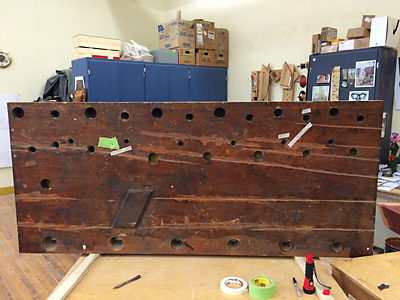
The Pedale windchests were conundrums. The concept is clever: the Pedale Sub Bass 16' is mechanically duplexed through the use of double pallets to provide a Bass Flute 8'. However, the construction was flawed: the crossgrain orientation of the tables, which are solid wood and 30" wide, caused extreme splitting. Over the years, many tubes of silicone were emptied into the cracks, to little avail. Because of the fatally flawed design, after much consideration we elected to build new chest tables of plywood, retaining the pallets and all other reusable original material, and store the original, now redundant chest components inside the organ.
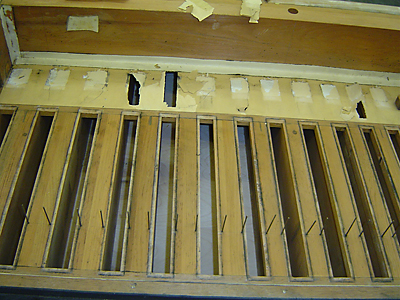
The area behind the Swell pallet openings was covered with paper that had become brittle over time.
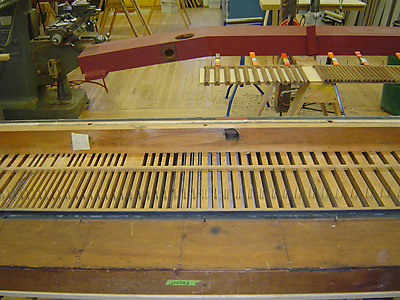
Because of its fragility, we removed all of this paper and replaced it with rubber cloth.
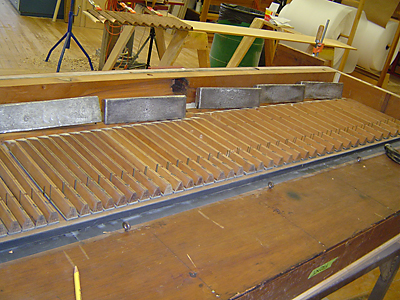
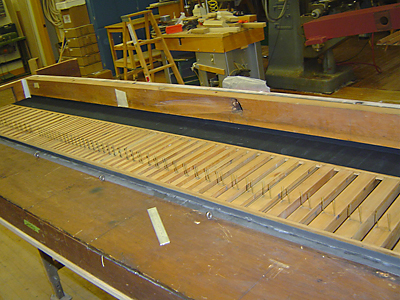
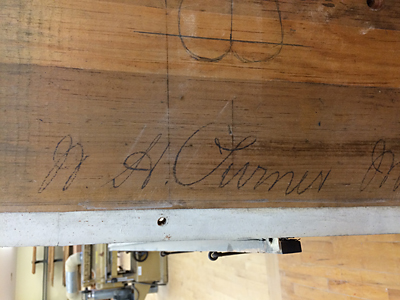
In the Pedale windchests, we found signatures of W.H. Turner, one of the English organ builders who emigrated to the U.S. in the 1860s.
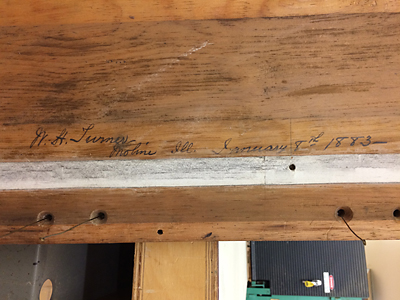
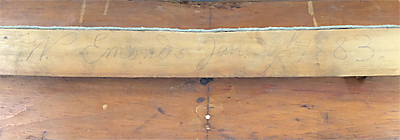
In the Swell windchest, we found the signature of Father William Emonds, pastor of St. Mary’s church at the time, on a pallet retaining rail.





